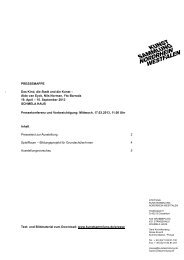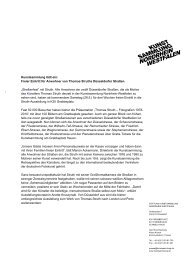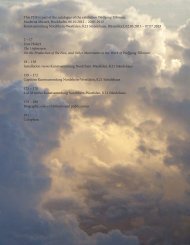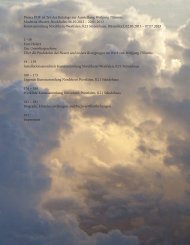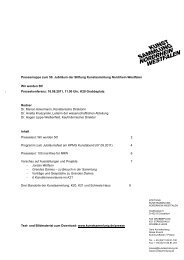Download online catalog (pdf)
Download online catalog (pdf)
Download online catalog (pdf)
You also want an ePaper? Increase the reach of your titles
YUMPU automatically turns print PDFs into web optimized ePapers that Google loves.
Tillmans prefers to talk of, 29 need not be restricted to the camera-based pictures, but may<br />
equally well include the photographs that owe their existence solely to gestural acts and chemical<br />
processes.<br />
Assimilating Photography into the Paradox<br />
By virtue of the portability and variability of his works, with every print, with every exhibition,<br />
with every publication Tillmans can modify and modulate anew the relations between picture<br />
and picture support, representation and presentation, motif and materiality. In the two decades<br />
that have elapsed since his entry into the art business his praxis has continuously expanded.<br />
From the outset photography was his springboard for both integrative and eccentric acts. And<br />
even though this œuvre may create the impression that the medium of photography knows no<br />
limits, photography – as discourse, as technique, as history, as convention – has remained the<br />
constant point of reference for all of Tillmans’ complex operations. It could also be said that he<br />
is immensely faithful to his chosen medium, although – or precisely because – that medium<br />
is not always recognisable as such. To quote an older essay on photography and painting<br />
by Richard Hamilton (whom Tillmans once photographed), his work is about ‘assimilating<br />
photography into the domain of paradox, incorporating it into the philosophical contradictions<br />
of art. . . .’ 30 Since Tillmans’ experiments with a laser copier in the 1980s, he has produced<br />
hundreds of images that may be beholden to the etymology of photography (light drawing)<br />
but that also constantly undermine or overuse the social and epistemological functions of<br />
photography as a means to depict reality, as proof, as an aide mémoire, as documentation or as<br />
a form of aesthetic expression. The discourse on photography, with all its ‘post-photographic’<br />
exaggerations, the debate on the status of the photographic image – none of these have been<br />
concluded; on the contrary, Tillmans is continuously advancing them on his own terms. His<br />
praxis forms the backdrop for experimentation and adventures in perception that are closely<br />
intertwined with the past and the present of photography and theories of photography; yet<br />
the specific logic of this œuvre creates a realm of its own in which archive and presentation<br />
interlock in such a way that photography still plays an important part as historic and discursive<br />
formation, but the problems and paradoxes of fine art have now taken over the key functions.<br />
The contagious impact of the epistemological problems of art has opened up new<br />
options for the medium of photography, new contexts of reception. And in this connection it<br />
is apparent, as Julie Ault has put it, that ‘Tillmans enacts his right to complex mediation’. 31 In<br />
other words, photography provides a means for him to engage with a whole range of interactions<br />
with the viewer. In his eyes and hands photography becomes a realm of potential, where<br />
a never-ending series of constellations and juxtapositions of materialities, dimensions and<br />
motifs of the ‘unforeseen’ can come about. Photography thus regains a dimension of experimentation,<br />
an openness that is not constrained by aesthetic formats and technical formatting<br />
but that does arise from a precise knowledge and understanding of the history of the medium.<br />
Layers and Groups<br />
Tillmans’ work has consistently expanded both horizontally and vertically, that is to say, it has<br />
developed not only in terms of its breadth, variation and selection of motifs and processes but<br />
29 See ‘Peter Halley in Conversation with Wolfgang Tillmans’, in Jan Verwoert, Peter Halley and Midori Matsui,<br />
Wolfgang Tillmans (London: Phaidon, 2002), 8–33 at 33.<br />
30 Richard Hamilton, ‘Photography and Painting’, in Studio International, vol. 177, no. 909, March 1969,<br />
120–125 at 125.<br />
31 Ault, ‘The Subject Is Exhibition’ (see note 8), 15.



